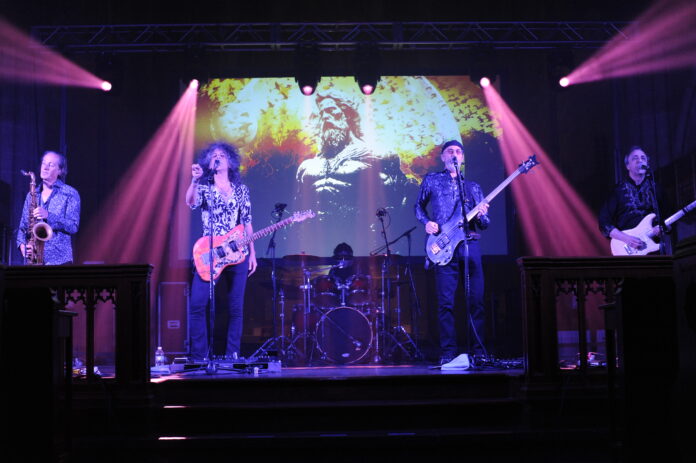On the evening of Tuesday, Sept. 24, Egner Memorial Chapel on Muhlenberg campus sprung alive with good vibes and transcendental tunes. WMUH treated the campus members of the College and the public to the epic comeback of psychedelic rock band GONG and the opening performance by Tim Motzer.
GONG’s band history is nonlinear and constantly in flux, all the while remaining timeless and consistently true to their work. Charles Snyder, an individual who is fairly knowledgeable of the group and sold their merchandise by the doors, explained and provided information on the fascinating past of GONG. Daevid Allen, a musician residing in Paris in 1967, created the group, consisting of members that throughout the decades to come would move in and out of roles throughout the decades to come; a constant concept of change. “This is a second-generation band currently, and if it weren’t for the original GONG, these five wouldn’t be here together,” Snyder acknowledged, as few original members still live today. The current performers are Fabio Golfetti (lead guitarist and vocalist), Dave Sturt (bassist, vocalist), Ian East (saxophone and flute), Kavus Torabi (vocalist, guitarist) and Cheb Nettles (drums, vocalist). Snyder reveals they all have been taught and mentored by Allen himself before his passing on Feb. 5, 2015.
Despite being no longer an active member, he remains an active influence with the band, performing songs in remembrance and tribute to him. “The band’s message is all about birth, death, rebirth and so on,” Paul Krempasky, WMUH general manager states as he gives insight into the process of organizing this event. The band is touring for the first time in the United States in 15 years. It was revealed that back in 2009, their last performance in the U.S. also took place in Lehigh University’s Zoellner Arts Center located in the Lehigh Valley. Krempasky goes on to explain that the Lehigh Valley is a “hot spot” for progressive rock, and the agent he had worked with prior reached out, connections proving to be of great importance once again. “The opportunity was just too much to pass up,” said Krempasky. He emphasizes how useful of an opportunity these events are for students to go out and explore.
Tim Motzer, who opened for the band, brought to the stage a kind of work that many most likely have not encountered before in their life (or very limited at least). An artist who designs his unique and abstract CDs and brush strokes to complement the music that is captured in them, he begins his set with the best choice of words, better than I can muster for a description, “sonic-painting.” A composer and guitarist who is local, Motzer plays music that, according to his website, is a fluid mix of “jazz, fusion, progressive, hip-hop, soul, electronics and the avant-garde…” As GONG has been long-standing, the two decades of touring and spreading his music have named him a prominent figure in exploring the bounds of sound.
“The band’s message is all about birth, death, rebirth…” – Paul Krempasky, WMUH general manager
Throughout the show, I was constantly reminded of how artistically-enriched and interpretive this type of music is. As Motzer began, I could compare it to the feel of meditation music/binaural beats which I am familiar with, but have figured his work doesn’t even come close to categorizing. Throughout, the audience witnessed the tedious and elaborate use of multiple instruments, tools, sounds and layering to bring together a series of vibrations and ambient songs that presented themselves as undergoing a journey. He explores a variety of sounds you can practically feel go through your body, leaving a transforming and impactful impression. After a very brief intermission, GONG entered, getting right into the heart of their rock and stage presence. The lights, the facial expressions and acting, the synchronicity that made them feel as if they were unbreakable, carried along throughout their songs. The visuals projected behind them produced trip-like depictions and images, their music loud, boisterous and funky. Audience members were seated in pews for the majority of the event, yet heads were bobbing, hands and feet were tapping, entranced by the rhythm, faces were tense and focused, undergoing the course of their set like a journey.
The ratio of students to public attendees varied, as it was approximately half and half. I came across student Ava Muller ‘28, who is a regular concertgoer (approximately twenty-some in the books), offering the perspective of her take on the night. Muller agrees that the claim to psychedelic fame was lived up to, the lighting and acoustics of the Chapel venue bringing it up a notch. The band themselves exclaimed during their performance about how neat it was to play in such a beautiful scene, highly symbolic in a sense. “I think going to a concert for a big fan is a religious experience, and to put it in a psychedelic space… it was just really cool,” gushed Muller, a very meaningful recount of the immersion.
This was a lively and community-uniting evening that brought students and old fans alike together as they waited for a chance to see these talented artists perform. Not only did it satisfy their hankerings for live music, but is also evident that all walked out taking with them a mind-opening, vivid and elevating experience to remember.





















